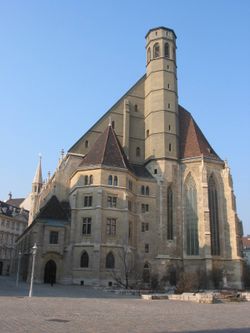
Minoritenplatz
Encyclopedia

Town square
A town square is an open public space commonly found in the heart of a traditional town used for community gatherings. Other names for town square are civic center, city square, urban square, market square, public square, and town green.Most town squares are hardscapes suitable for open markets,...
s in Vienna
Vienna
Vienna is the capital and largest city of the Republic of Austria and one of the nine states of Austria. Vienna is Austria's primary city, with a population of about 1.723 million , and is by far the largest city in Austria, as well as its cultural, economic, and political centre...
. It is located in the first district Innere Stadt
Innere Stadt
The Innere Stadt is the 1st municipal District of Vienna . The Innere Stadt is the old town of Vienna. Until the city boundaries were expanded in 1850, the Innere Stadt was congruent with the city of Vienna...
, and is dominated by the Minoritenkirche
Minoritenkirche, Vienna
The Minoritenkirche, formal name: Italienische Nationalkirche Maria Schnee is a church built in French Gothic style in the Altstadt or First District of Vienna, Austria.The site on which the church is built was given to followers of Francis of Assisi in 1224...
church, after which the square is named. The church itself was constructed by the Greyfriars (Minoriten), after the Austrian Duke Leopold VI of Austria invited them to Austria in 1224. Since the square is in direct proximity to the Hofburg Imperial Palace
Hofburg Imperial Palace
Hofburg Palace is a palace located in Vienna, Austria, that has housed some of the most powerful people in Austrian history, including the Habsburg dynasty, rulers of the Austro-Hungarian empire. It currently serves as the official residence of the President of Austria...
, a number of aristocratic families
Austrian nobility
Historically, the Austrian nobility was a privileged social class in Austria. The nobility was officially abolished in 1919 after the fall of the Austro-Hungarian Empire. Former noble families and their descendants are still a part of Austrian society today, but they no longer retain any specific...
took up residence in the square from the 16th to the 18th century.
City-palaces (Palais) located at the Minoritenplatz are:
- Palais Dietrichstein (constructed in 17th century, located at Minoritenplatz 3)
- Palais LiechtensteinPalais LiechtensteinPalais Liechtenstein may refer to:* Stadtpalais Liechtenstein , in the I. district of Vienna Innere Stadt* Gartenpalais , in the IX. district Alsergrund, currently houses the extensive art collection of the Liechtenstein princes...
(1706, Minoritenplatz 4, entrance also at Bankgasse 9) - Palais Starhemberg (1650-1661, Minoritenplatz 5)
- Palais NiederösterreichPalais NiederösterreichPalais Niederösterreich, historically known as the Niederösterreichisches Landeshaus , is a historical building in Vienna....
(1839-1848, Minoritenplatz 7, entrance also at HerrengasseHerrengasseThe Herrengasse is a street in Vienna, located in the first district Innere Stadt.-History:...
13) - Landeshauptmannschaft (formerly Statthaltereigebäude, Minoritenplatz 9, entrance also at Herrengasse 11)
Located on Minoritenplatz 1 are the Austrian State Archives (Österreichisches Staatsarchiv), founded in the 15th century by Maximilian I, Holy Roman Emperor
Maximilian I, Holy Roman Emperor
Maximilian I , the son of Frederick III, Holy Roman Emperor and Eleanor of Portugal, was King of the Romans from 1486 and Holy Roman Emperor from 1493 until his death, though he was never in fact crowned by the Pope, the journey to Rome always being too risky...
as the Family, Court and State Archive (Haus-, Hof- und Staatsarchiv). The building itself now only dates back to 1901.
Close to the Archives is the Austrian Federal Ministry for Foreign Affairs, located at Minoritenplatz 8.
Small monuments to the artist Rudolf von Alt, the cleric Clemens Maria Hofbauer
Clemens Maria Hofbauer
Clemens Maria Hofbauer was a hermit and is the patron saint of Vienna.- Childhood and early priesthood :...
, and the politician Leopold Figl
Leopold Figl
Leopold Figl was an Austrian politician of the Austrian People's Party and the first Federal Chancellor after World War II...
also decorate the square.

